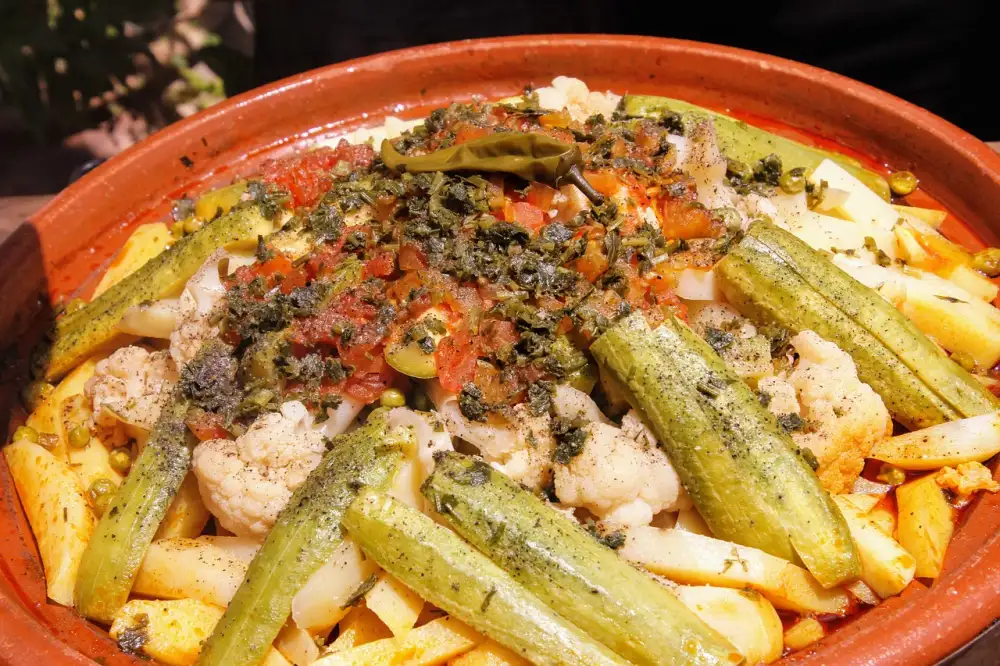Discover the Exotic Flavors of Tagine: A Moroccan Stew Recipe to Transport Your Taste Buds

Tagine is a traditional North African stew that has captivated taste buds around the world with its rich flavors and aromatic spices. Named after the earthenware pot in which it is cooked, tagine is a popular dish in Moroccan cuisine known for its tender meat, vibrant vegetables, and unique blend of sweet and savory ingredients. This slow-cooked stew is not just a meal but an experience that transports you to the bustling markets and vibrant culture of Morocco with every bite. Join us on a culinary journey as we explore the exotic flavors of tagine and learn how to recreate this delicious dish in your own kitchen.
History and Origin of Tagine
Tagine, a flavorful Moroccan stew cooked in a distinctive cone-shaped pot, has a rich history dating back centuries. The dish gets its name from the earthenware pot it is cooked in, also called a tagine. Historically, Berbers in North Africa used tagines to slow-cook meats, vegetables, and spices over hot coals. This method allowed for tender and aromatic dishes perfect for sustaining desert nomads on their journeys. Over time, tagine recipes evolved with influences from Arab and Andalusian cuisines, creating the diverse flavors we enjoy today.
Traditional Ingredients Used in Tagine
Tagine, a beloved Moroccan stew, is known for its rich and aromatic flavors that come from a unique blend of traditional ingredients. The key components typically include tender meat such as lamb, chicken, or beef, combined with an assortment of vegetables like carrots, potatoes, tomatoes, and onions.
To enhance the dish's flavor profile, a variety of herbs and spices are added, such as cumin, coriander, paprika, cinnamon, saffron, and ginger. These ingredients not only infuse the tagine with warmth and depth but also contribute to its distinctive North African taste.
Additionally, dried fruits like apricots or prunes are often incorporated into the tagine to provide a subtle sweetness that balances out the savory elements. Olive oil is commonly used for cooking the ingredients and adding richness to the sauce.
The combination of these traditional ingredients creates a harmonious blend of flavors that make tagine a truly special dish that captures the essence of Moroccan cuisine.
Step-by-Step Guide on How to Cook Tagine
1. Start by marinating your choice of protein (chicken, lamb, beef) with traditional Moroccan spices like cumin, paprika, turmeric, and cinnamon for at least 30 minutes.
2. Heat olive oil in a tagine pot over medium heat and sauté chopped onions until translucent.
3. Add the marinated protein and brown it on all sides to seal in the flavors.
4. Layer vegetables such as carrots, potatoes, tomatoes, and olives over the meat.
5. Pour in a mixture of water or broth along with additional spices like saffron threads and preserved lemons.
6. Cover the tagine pot with its conical lid and let it simmer on low heat for about 1-2 hours until the meat is tender and the flavors have melded together.
7. Check occasionally to ensure there is enough liquid in the pot; add more if needed.
8. Garnish with fresh herbs like cilantro or parsley before serving hot with couscous or crusty bread.
Enjoy this aromatic dish that captures the essence of Moroccan cuisine!
Tips for Perfecting Your Tagine Dish
**Tips for Perfecting Your Tagine Dish**
1. **Choose the Right Cut of Meat**: Opt for cuts like lamb shoulder or beef chuck that are suitable for slow cooking and will become tender and flavorful in the tagine.
2. **Marinate the Meat**: Marinating the meat in a blend of spices, herbs, and olive oil overnight can enhance the flavors and tenderize the meat before cooking.
3. **Layer Ingredients Carefully**: Layering ingredients in the tagine pot ensures even cooking and allows flavors to meld together beautifully. Start with meat at the bottom, followed by vegetables and fruits.
4. **Use Fresh Ingredients**: Fresh herbs, spices, and seasonal vegetables will elevate the taste of your tagine dish. Avoid using dried or old ingredients for a more vibrant flavor profile.
5. **Monitor Cooking Time**: Slow cooking is key to developing rich flavors in tagine. Keep an eye on the dish while it simmers to prevent overcooking or drying out.
6. **Adjust Seasoning**: Taste your tagine as it cooks and adjust seasoning accordingly. Adding a pinch of salt or a squeeze of lemon juice towards the end can balance flavors perfectly.
By following these tips, you can ensure that your tagine dish turns out flavorful, aromatic, and authentically Moroccan every time you cook it!
Variations and Adaptations of Tagine Recipes
When it comes to variations and adaptations of Tagine recipes, the possibilities are endless. While the traditional Tagine typically includes ingredients like lamb or chicken with vegetables and dried fruits, modern versions have evolved to cater to different tastes and dietary preferences. Vegetarian options can substitute meat with chickpeas, lentils, or tofu for a protein-rich alternative. Seafood lovers can enjoy a seafood Tagine with fish or prawns cooked in a flavorful broth. Experimenting with spices like cumin, paprika, cinnamon, and saffron can also add unique twists to the dish, allowing you to customize the flavors to your liking. Additionally, fusion Tagine recipes incorporate ingredients from other cuisines, such as Asian-inspired Tagines with ginger and soy sauce or Mexican-infused Tagines with jalapeños and cilantro. The beauty of Tagine lies in its versatility, making it a dish that can be tailored to suit various palates while still retaining its essence of slow-cooked goodness.
Serving Suggestions and Accompaniments for Tagine
Tagine is traditionally served with a side of couscous, a staple in Moroccan cuisine. The light and fluffy texture of couscous complements the rich and flavorful stew of the tagine perfectly. Additionally, a fresh salad made with tomatoes, cucumbers, and red onions dressed with lemon juice and olive oil can provide a refreshing contrast to the warm and hearty tagine dish.
To enhance the dining experience, consider serving tagine with a selection of Moroccan bread such as khobz or msemen. These breads are perfect for soaking up the delicious sauce from the tagine. For those looking to add some heat to their meal, Harissa, a spicy chili paste commonly used in North African cuisine, can be served on the side.
To complete your tagine feast, offer traditional mint tea as a beverage choice. The sweet and aromatic tea helps cleanse the palate after indulging in the bold flavors of the tagine stew. With these authentic accompaniments, your tagine meal will truly transport your taste buds to Morocco's vibrant culinary landscape.
Health Benefits of Eating Tagine
Tagine, a traditional Moroccan stew, offers a plethora of health benefits due to its nutrient-rich ingredients and cooking method. The slow-cooking process helps retain the nutrients in the ingredients, making it a wholesome meal choice. Tagine typically includes lean proteins like chicken or lamb, which are excellent sources of high-quality protein essential for muscle growth and repair. Additionally, the abundance of vegetables and fruits in tagine provides a wide array of vitamins, minerals, and antioxidants that support overall health and well-being. The use of aromatic spices like cumin, cinnamon, and turmeric not only enhances the flavor but also adds medicinal properties such as anti-inflammatory and antioxidant effects. Moreover, the incorporation of healthy fats from olive oil or nuts in tagine contributes to heart health by reducing cholesterol levels and inflammation in the body. By enjoying a serving of tagine, you can savor a delicious meal while nourishing your body with essential nutrients that promote good health.
In conclusion, Tagine is not just a dish; it's a culinary journey that tantalizes the taste buds with its exotic flavors and rich history. This Moroccan stew brings people together around the dining table to savor the warmth and depth of its spices. By exploring the world of Tagine, we not only indulge in delicious meals but also appreciate the cultural significance of this traditional dish. So, next time you gather with loved ones for a meal, consider adding Tagine to your menu for an unforgettable dining experience that celebrates both food and heritage.
Published: 30. 04. 2024
Category: Recipes



